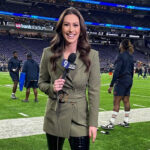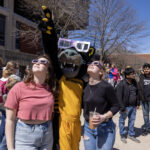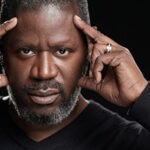Each year UWM’s Office of Undergraduate Research honors several seniors with its Senior Excellence in Research Awards. These students have worked with faculty mentors in a variety of fields over recent years and continue to share their experiences as ambassadors for undergraduate research. Here are the projects and research the 2019-2020 SERA students are working on.
Robert Aloisi
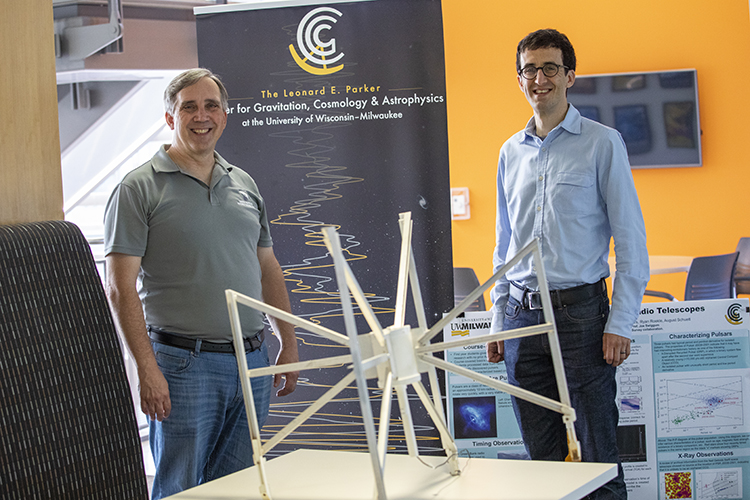
Major: Physics with an astronomy emphasis
Robert Aloisi left his career of 29 years as a product development engineer to pursue his passion for the stars.
He came to UWM two years ago to work on a bachelor’s degree in physics, with the goal of eventually earning his doctorate in astronomy. He chose the physics department at UWM because it was within commuting distance of his home in Sheboygan Falls and offered the opportunity to do undergraduate research.
His first-year research experience was studying the properties of pulsars, which are compact, very dense stars that emit radio energy as they spin. That resulted in a paper, written with five students and other co-authors, that was published in The Astrophysical Journal.
Last summer, he spent 11 weeks in Australia at the University of Sydney as an intern working with a new telescope array called ASKAP (Australian Square Kilometer Array Pathfinder), an opportunity available to UWM students as part of GROWTH (Global Relay of Observatories Watching Transients Happen).
One goal of the work is to find supernovae and better understand their properties, research that he is continuing this academic year with the data collected in Australia.
“A neat example I found this summer was a supernova that was discovered the month I was born. The afterglow of that supernova is still visible today. That was pretty cool.”
Aloisi’s research mentor is David Kaplan, associate professor of physics, and he’s also worked closely with postdoctoral mentors Angie Van Sistine and Joe Swiggum.
“I really enjoyed doing research with the teams that I’ve worked with. I find that I learn a lot along the way to accomplishing projects,” Aloisi said. “I find it really rewarding to have been able to publish a paper already. The trip to Sydney was just awesome both on a professional level and a personal level.”
Bella Biwer
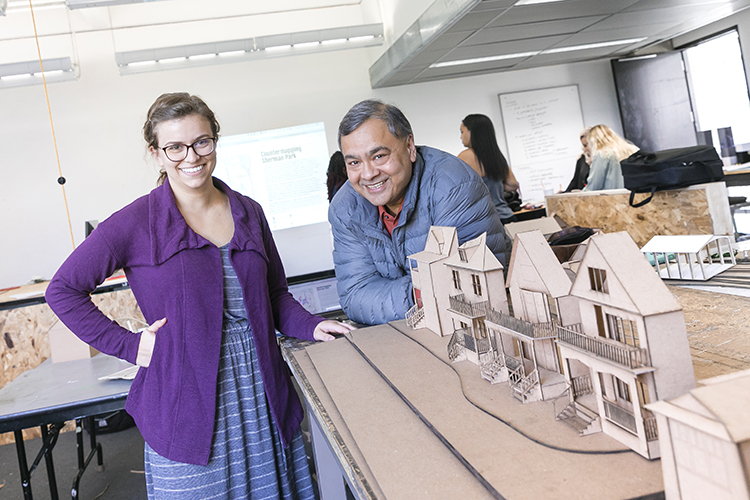
Major: Architecture, with a minor in structural engineering
Bella Biwer has been working with Associate Professor Arijit Sen researching the Sherman Park, Washington Park and Thurston Woods neighborhoods.
Out of that interest in how people perceive neighborhoods and perceptions of safety in the urban environment grew a series of “Jane’s Walks,” named for Jane Jacobs, for a pioneering urban activist and writer.
“She started holding walks around neighborhoods that were led by community members who told everybody else about their neighborhood and what they thought was important,” said Biwer. Since the 2017-18 academic year, she and Sen have organized seven walks in Milwaukee neighborhoods. This year, they are writing up the results.
Biwer has focused the majority of her work in the Center Peace neighborhood of Sherman Park, bounded by North 44th Street, North 38th Street, West Center Street and West Meinecke Avenue. Center Peace is a name the community members came up with themselves, according to Biwer.
The interactive “Countermapping Sherman Park” map they developed looks at how the community members view their neighborhood. “Instead of deciding from the top down which places are important, community members decide which places are important,” Biwer said.
“You can click on each of the places and it has descriptions and photos and recordings of community members talking about them.”
She is also co-writing a paper with Sen titled “Urban Safety and Resistance; Sherman Park, Milwaukee,” which will be presented at the Humanities Action Lab’s Initiative on Climate and Environmental Justice at Rutgers University this spring.
Biwer said her undergraduate research and working with mentors like Sen and UWM alumna Allyson Nemec of Quorum Architects have helped her stand out from peers and make connections in her field.
“It’s helped me be more independent. Instead of always being in classes where they’re telling you what to do, this was a little more open,” Biwer said.
“Because I started doing it even before I started as a freshman, I was open to the whole city very quickly instead of just the neighborhood around the campus.”
Bailey Flannery
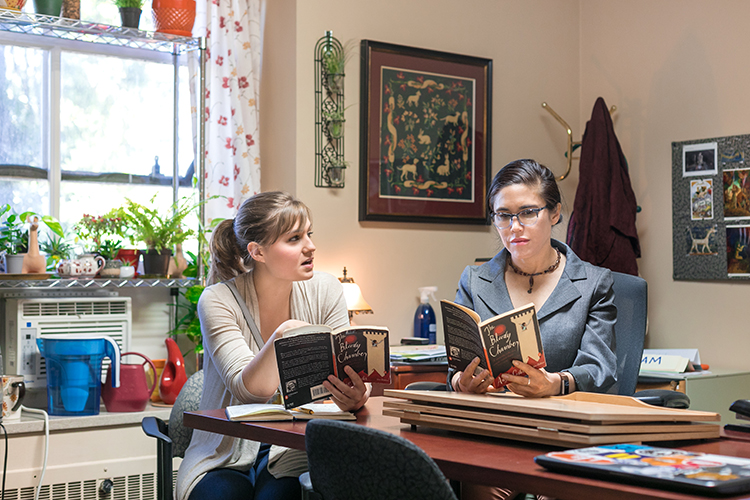
Major: English
Bailey Flannery loved English and thought she’d like to be a high school teacher. But then she took a course from Jacqueline Stuhmiller, lecturer in the Honors College, and discovered the opportunities that existed for doing research in the humanities.
“I took her course ‘Telling Tales: Medieval Story Telling,’ and that class just changed my life,” Flannery said. “It captured my interest, my imagination.”
“I always envisioned research as being someone in a lab coat with a test tube with maybe a microscope.” But when Stuhmiller sent her some examples of research writings in the humanities, Flannery decided that was something she could do.
Her particular focus has been on the treatment of women and their bodies in literature as the monstrous female body or woman-animal interface.
“Highlighting these different representations was a way to start conversations with people in a way that might feel more approachable to them,” said Flannery.
As part of the work, she has helped organize two Monster Conferences and a Beastly Conference that have explored the topics of monsters and beasts in literature. The monster conference brought in student researchers from other areas and outside the university.
Currently, Flannery is working with Stuhmiller as a research assistant on a volume called “Animal Husbandry: Bestiality in Medieval Culture.” In addition to the Honors College Beastly and Monster conferences, she’s presented at the Arizona Center for Medieval and Renaissance Studies and the Animals in the Humanities conference.
Working with other researchers in the humanities and social sciences, she has also created an organization called HARPY, or Honors Association for Research and Publication, that will publish its first undergraduate academic journal in the spring of 2020.
Undergraduate research has changed her life, Flannery said. “I think research in the humanities pushes you to be a more critical and compassionate thinker. It pushes you to have uncomfortable conversations… you may not agree with the ideas, but you understand them. I think these are things our deeply divided society needs more of right now.”
On a personal note, she adds, “It’s changed me as a person because it’s given me invaluable research experience. It’s helped me prepare for graduate school and given me experience in talking to other people about my ideas, presenting at conferences where you have to be at the top of your game.”
Ryan Majinski
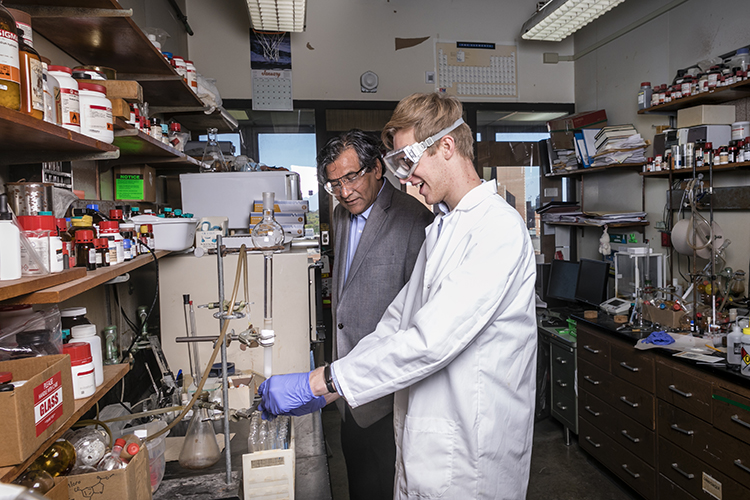
Major: Biomedical sciences
Ryan Majinski is working in an organic chemistry laboratory under his mentor Mahmun Hossain, developing a precursor molecule to many modern medicines.
Since the Hossain Laboratory Group has developed a synthetic route that serves as the first steps in forming biologically active compounds, Majinski is using his final year to research the synthesis of all-carbon quaternary stereocenter-containing compounds, a type of molecule that includes four different carbon functional groups in close proximity, allowing for numerous pharmaceutical applications.
“A lot of modern medicines, along with some natural products, contain this basic structure, but it’s hard to make synthetically, Majinski said. The goal is to fine tune and test the reaction to increase the yield, eliminate unwanted materials and remove impurities. The end product could eventually be used to make new blood thinners, painkillers and some anti-cancer agents.
Majinski was interested in medical research and was eager to start looking into opportunities as soon as he came onto campus freshman year. “When I found Dr. Hossain’s project information on the Office of Undergraduate Research website, I was really fascinated with all the implications down the line in terms of future medicine.”
Majinski was also able to further develop his interests in medicine in his choice of major. “The biomedical sciences major helps prepare medical lab scientists, the professionals who do all the standard testing for disease diagnosis,” Majinski said.
He eventually plans to become a pediatrician, and his experience as a biomedical sciences major will lend itself well to this future role, he said. He is also able to help other students get involved in medically related opportunities as president of the American Medical Student Association at UWM.
He was drawn to UWM by the cutting edge research and the location. His campus visit with a “phenomenal” tour guide convinced him this was the place for him. “It just seemed like they really cared about their students. This was right after UWM became an R1 research institution, and I knew there would be plenty of opportunities to get involved.
“I am excited about my future in research and medicine both at UWM and beyond.”
Nikolaus Prusinski
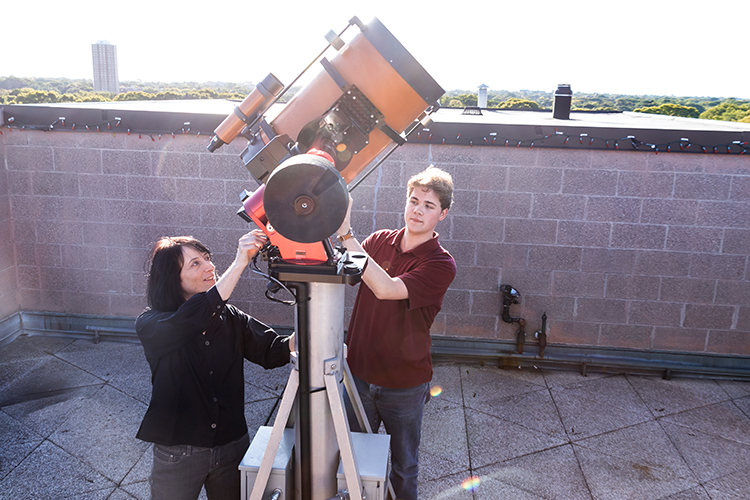
Majors: Astrophysics, mathematics
Nik Prusinski’s many childhood visits to UWM’s Manfred Olson Planetarium inspired him to become an astronomer.
“That’s when I met Dr. Jean Creighton (planetarium director). Her shows are excellent. They really do a good job of introducing astronomy to the general public. I strive to achieve her level of ease with science communication.”
Prusinski finished up most of his general high school curriculum by the time he was 15, so his school board sponsored him through the Youth Options program to take classes at UWM.
“UWM is close to St. Francis, has a great physics/astronomy program and is cost-effective,” Prusinski said. As a result, he’ll be graduating from UWM at age 19.
His research has focused on studying star formation and galactic outflows in the early universe under the guidance of Dawn Erb, associate professor of physics. Using data from the Hubble and Keck telescopes, Prusinski observes outflowing gas to better understand feedback processes influencing star formation.
Prusinski worked as a volunteer at the planetarium, which transitioned into a paid internship. He is now lead stargazer, presenting live shows to the general public. Among other projects, he helped install a new computerized tracking mount for the telescope on the roof of the Physics building. The mount allows the telescope track the stars as they move across the sky. He’s also done an NSF-funded summer research experience at Northwestern University.
The work he is doing with his mentor can help contribute to a better understanding of the universe and how galaxies have evolved over time, he said. She has helped him not only with the research, he added, but with advice on graduate school. “She is a great career mentor as well as a research mentor.”
Having received several graduate school offers, Prusinski’s goal is to earn his PhD in astrophysics and become a research professor. He’s enjoyed presenting his research, he said, and seeing the ‘aha’ moment in his teaching. “I enjoy sharing the beauty and mystery of the cosmos. That ties into my work with the planetarium. Having people come up to the roof and look through the telescopes and see the planets and moon…that’s super fun.”
Tessa Miskimen
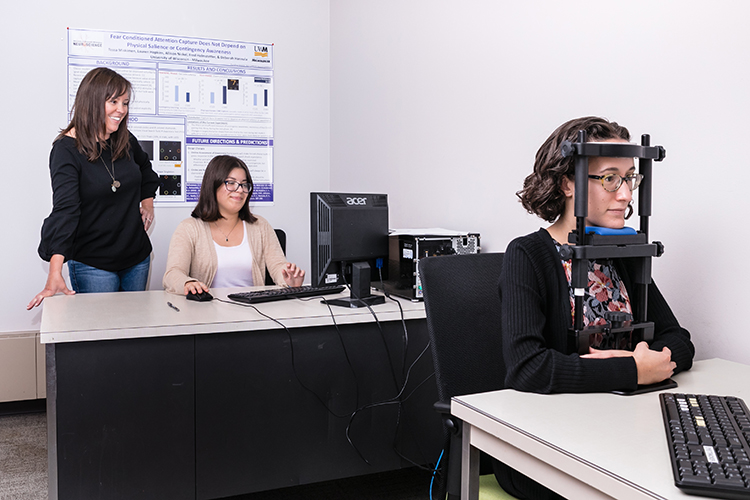
Major: Psychology
Tessa Miskimen works in Associate Professor Debbie Hannula’s psychology and neurosciences laboratory doing research on learning and memory.
Miskimen has been taking part in an ongoing project looking at how fear conditioning can influence people’s eye movements. For example, viewers look at different colored circles on a computer screen with certain colors accompanied by a shock. Miskimen then tracks their responses to seeing the same circles again. “Because of what they’ve learned, they remember something about what the circle meant to them beforehand in terms of shock.”
The goal of the research is to study the parts of the brain that are activated by the eye movements reflecting remembered stimuli.
“We know a lot about the brain, but we also don’t know a lot at the same time,” she said.
She works with graduate students in Hannula’s lab who are doing functional MRI (fMRI) studies with video recordings. That’s work she won’t be able to see out fully before her May graduation, Miskimen said.
“An MRI shows a picture of the brain, but an fMRI shows changes in blood flow that show us what part of the brain is activating when certain stimuli are presented, for example,” Miskimen said.
She received an award for her research presentation at the UWM Undergraduate Research Symposium two years in a row and has taken part in a national conference as well.
Miskimen has been doing undergraduate research since the second semester of her first year. “I was in Dr. Hannula’s freshman seminar and after that class, she invited me to be in her lab. I didn’t really know if I wanted to be involved in research, but I decided to take advantage of the opportunity.”
She became interested in psychology after an AP psychology course in high school. Her work at UWM introduced her to the science side of the field, which is where she has focused her research. “I didn’t realize there was so much to psychology until I started taking classes here. I learned a lot about neuroscience in my freshman seminar with Dr. Hannula.”
She said she’s benefitted from her research experiences and her psychology classes at UWM. “I feel very connected and able to ask questions of many professors, even if I haven’t had a class with them for a year or two.” Graduate researchers she’s worked with have also been a great source of advice and information as she looks at graduate school, she added.
Her advice to others is to take advantage of research opportunities. “I didn’t come in thinking I would do research…I didn’t know if field study or an internship was what I wanted to do. But I just took advantage of opportunities as they came.”
Nicole Vigon
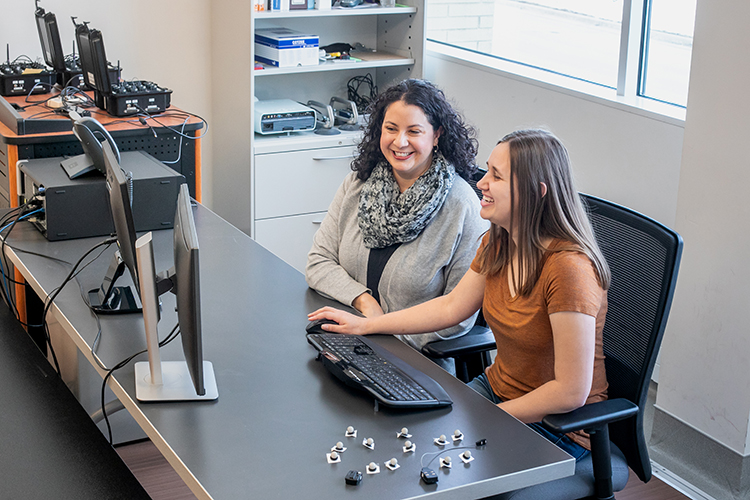
Major: Biomedical engineering
Nicole Vigon started out in mechanical engineering, but soon decided she wanted to be involved in working to research and engineer prosthetics, therapies and other ways of helping people with mobility issues.
She is currently working with Associate Professor Brooke Slavens, studying children with hypermobile type Ehlers-Danlos Syndrome (hEDS). This syndrome is a connective tissue disorder that results in overly flexible joints, leading to early onset osteoarthritis. It’s often misdiagnosed, and the children may grow up with considerable pain.
With Slavens, she is helping study the kinematics and kinetics of the children’s gait. Their work is done in collaboration with Children’s Hospital of Wisconsin, which is studying the genetic component of the disorder. They are working together to lead to the characterization of the biomedical phenotype.
Vigon is one of the first graduates of the relatively new biomedical engineering major. During her years at UWM, she has served as the College of Engineering and Applied Science ambassador, meeting with teachers, parents and prospective students. She is also a mentor to College of Engineering students and a peer mentor in WiscAMP. She is the cofounder of UWM Supermileage, a group that competes to build vehicles that use fuel most efficiently.
Undergraduate research has been a key part of her time at UWM.
“When I came here in my freshman year, I wasn’t sure if I wanted to do mechanical or biomedical. Knowing that I could get involved as early as before my freshman year with research was something that was really critical to me. When I’m working with the faculty, they’re very encouraging and love to have students in their labs. Finally, knowing that UWM is a top rated research university was super cool and important for me.”
